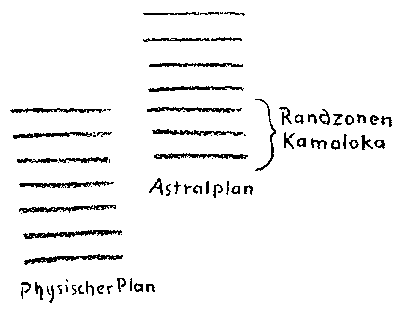Physical world: Difference between revisions
No edit summary |
|||
| Line 1: | Line 1: | ||
The '''physical world''' in the broadest sense, which appears to us as the sensual external world, is often also called the '''physical | The '''physical world''' in the broadest sense, which appears to us as the sensual external world, is often also called the '''physical plane''', the '''world of the intellect''', and together with the [[etheric world]], the '''physical-etheric world'''. In the Jewish [[Kabbalah]], the physical-material world is called [[Assiah]] ({{HeS|עולם עשיה}} '''Olam Asiyah''', "the world of action"). In the Jewish Kabbalah, the etheric world is called [[Jetzirah]], also ''Jetzirah'' or ''Yetzirah'' ({{HeS|עולם יצירה}} '''Olam Yetsirah''', "the world of shaping"). | ||
== Physical and physical-etheric world == | == Physical and physical-etheric world == | ||
Revision as of 14:31, 2 April 2021
The physical world in the broadest sense, which appears to us as the sensual external world, is often also called the physical plane, the world of the intellect, and together with the etheric world, the physical-etheric world. In the Jewish Kabbalah, the physical-material world is called Assiah (Hebrew: עולם עשיה Olam Asiyah, "the world of action"). In the Jewish Kabbalah, the etheric world is called Jetzirah, also Jetzirah or Yetzirah (Hebrew: עולם יצירה Olam Yetsirah, "the world of shaping").
Physical and physical-etheric world
The physical world in the narrower sense refers to the realm of the four elements, while the physical-etheric world comprises a total of seven levels:
| } | etheric world | |
| } | physical world |
„We have the light ether, we have the warmth ether, but it actually has two parts, two layers; one is the earthly layer of heat, the other is the cosmic layer of heat, and they continually play into each other. In fact, we have not one but two kinds of heat, the heat that is actually of earthly, telluric origin, and that which is of cosmic origin. They constantly play into each other. Then we have air adjacent to the heat ether. Then would come water and earth, and above would come chemical ether, life ether.“ (Lit.:GA 230, p. 81)
The lowest 3 regions of the astral world (glow of desire, mobile sensitivity and region of wishes) overlap with the 3 uppermost regions of the physical-etheric world (light ether, sound ether and life ether) and it is here that the Kamaloka is to be found:
„If we start from the physical plan, we have here (it is drawn) seven sub-divisions of the physical plan; then would come seven sub-divisions of the astral plan. Of these, the three lowest coincide with the three highest of the physical plan. We must regard the astral plan as being pushed together with the physical plan in such a way that the three uppermost sections of the physical plan are at the same time the three lowermost sections of the astral plan. We can speak of a marginal zone, that is, the one which our souls cannot leave after death, when they are still bound to the earth by desires. It is called kamaloka.“ (Lit.:GA 101, p. 223)

Physical world, material world and sensual world
The physical world must be clearly distinguished from the material world on the one hand and the sensual world on the other:
The physical world is the world of physical form forces and laws. In its pure form it can only be experienced supersensually. For sensual perception, the world of physical forms only becomes visible when it is filled with substances. The substances darken the supersensible worlds and act as a mirror that throws the astral world back into consciousness in the form of the outwardly perceived sense qualities and the inwardly experienced desires, wishes and as lust or lack of lust, and reveals the spiritual world, the Devachan, to man in the form of the earthly thought life. This gives rise to our earthly consciousness as object consciousness, in which subject and object are (apparently) divorced from each other.
On the physical plan the life ether has its true life:
„The seventh is the physical plan. There the life ether lives in its true element. Life is perceived in the life ether. The life ether is also called atomistic ether, because on this plan it has its own life, its own centre. What lives on the same plan has its centre on the same plan.“ (Lit.:GA 93a, p. 46)
Literature
- Rudolf Steiner: Grundelemente der Esoterik, GA 93a (1987) English: rsarchive.org German: pdf pdf(2) html mobi epub archive.org
- Rudolf Steiner: Ursprungsimpulse der Geisteswissenschaft, GA 96 (1989), ISBN 3-7274-0961-4 English: rsarchive.org German: pdf pdf(2) html mobi epub archive.org
- Rudolf Steiner: Mythen und Sagen. Okkulte Zeichen und Symbole, GA 101 (1992) English: rsarchive.org German: pdf pdf(2) html mobi epub archive.org
- Rudolf Steiner: Geisteswissenschaftliche Menschenkunde, GA 107 (1988), ISBN 3-7274-1070-1 English: rsarchive.org German: pdf pdf(2) html mobi epub archive.org
- Rudolf Steiner: Erfahrungen des Übersinnlichen. Die drei Wege der Seele zu Christus, GA 143 (1994), ISBN 3-7274-1430-8 English: rsarchive.org German: pdf pdf(2) html mobi epub archive.org
- Rudolf Steiner: Der Mensch als Zusammenklang des schaffenden, bildenden und gestaltenden Weltenwortes, GA 230 (1993), ISBN 3-7274-2300-5 English: rsarchive.org German: pdf pdf(2) html mobi epub archive.org
 |
References to the work of Rudolf Steiner follow Rudolf Steiner's Collected Works (CW or GA), Rudolf Steiner Verlag, Dornach/Switzerland, unless otherwise stated.
Email: verlag@steinerverlag.com URL: www.steinerverlag.com. Index to the Complete Works of Rudolf Steiner - Aelzina Books A complete list by Volume Number and a full list of known English translations you may also find at Rudolf Steiner's Collected Works Rudolf Steiner Archive - The largest online collection of Rudolf Steiner's books, lectures and articles in English. Rudolf Steiner Audio - Recorded and Read by Dale Brunsvold steinerbooks.org - Anthroposophic Press Inc. (USA) Rudolf Steiner Handbook - Christian Karl's proven standard work for orientation in Rudolf Steiner's Collected Works for free download as PDF. |
